Inferno turned miracle
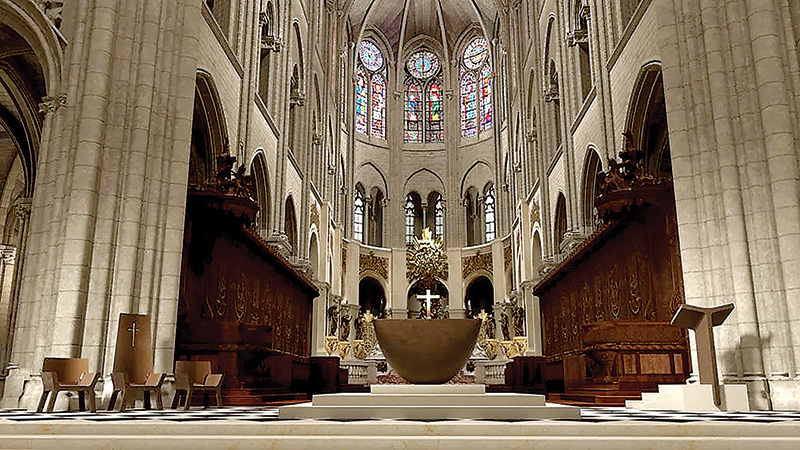 PARIS — In 2017, The New York Times reported that Notre Dame Cathedral was in dire need of a makeover. Weather and time had taken a toll on the edifice. Broken gargoyles were replaced by plastic and limestone crumbled at the touch, with a renovation expected to exceed $180 million.
PARIS — In 2017, The New York Times reported that Notre Dame Cathedral was in dire need of a makeover. Weather and time had taken a toll on the edifice. Broken gargoyles were replaced by plastic and limestone crumbled at the touch, with a renovation expected to exceed $180 million.
The interest in saving it from misery, however, was minimal.
Little did anyone know that two years later, the icon of Paris would be burning, with shocked Parisians flocking to the streets April 15, 2019, praying for their heroic firefighters – one of the best fire brigades in the world – as they tried to save the soul of the city. Millions of people all over the world were glued to their television screens, many in tears.
Within hours after the fire was contained, donors pledged almost $1 billion to restore the Parisian icon to its former glory. But it has been a long and busy five years – and a budget of $760 million – that has led to the restoration of the beloved cathedral and its planned Dec. 8 reopening.
Monday of Holy Week
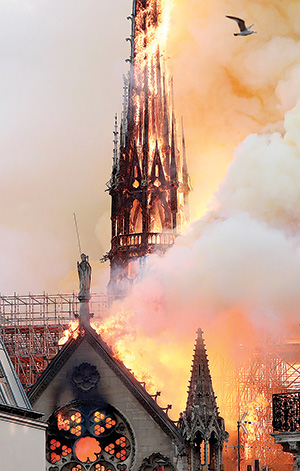
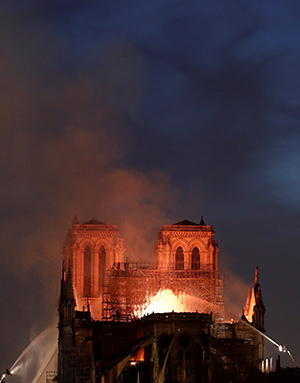 It was a Monday, 6:30 p.m. local time, when stunned passersby looked on from Parisian bridges as the fire engulfed the spire and most of Notre Dame’s roof.
It was a Monday, 6:30 p.m. local time, when stunned passersby looked on from Parisian bridges as the fire engulfed the spire and most of Notre Dame’s roof.
It was no ordinary Monday, however. It was Holy Week.
“Catholics should be commemorating Jesus’ crucifixion and resurrection in its pews at Holy Thursday, Good Friday and Easter Sunday services. Instead, a massive inferno is threatening to destroy the culturally and religiously significant icon for good,” USA Today wrote as Catholics and non-Catholics around the world held their breath.
The cathedral burned until the next morning, Tuesday, April 16.
Europeans woke up to a painful hole in place of the cathedral’s spire and images of its devastated interior, with one heartbreaking picture going viral: ashes still smoking as sunbeams shone through the collapsed roof, spotlighting the rubble that used to be the main altar.
Paris’ fire brigade got the blaze under control, and the main structure – including the bell towers and rose windows – was saved. No one was injured, and the relics housed in the cathedral and priceless works of art were rescued.
Father Jean-Marc Fournier was a witness to the moment the fire began to attack the north tower. As chaplain to the Paris fire department, he was on the scene, taking part in the massive operation with the 600 firefighters mobilized.
Saving what matters most
With the help of a team of colleagues, he had taken Jesus’ crown of thorns to safety – a relic particularly dear to his heart, and one of Notre Dame’s most valuable treasures. As a member of the Equestrian Order of the Holy Sepulchre of Jerusalem, he felt an urgency to ensure its protection.
“After the crown of thorns, I helped save a number of works of art, paintings … and altar furnishings, and then I became concerned with the Blessed Sacrament,” Father Fournier told OSV News.
“There was the Blessed Sacrament in the tabernacle of the high altar, but it was absolutely impossible to reach it! There were blazing infernos on the floor in front, with tangles of beams burning, showers of flames and molten lead falling from the roof. It was a furnace,” he said.
“Surprisingly, the statue of the Virgin Mary of the Pillar was immaculate, unharmed in this glowing atmosphere,” Father Fournier pointed out.
There was a second reserve of consecrated hosts at the altar of St. George, one of the chapels around the choir, Father Fournier recalled. “There, on the contrary, there was a great silence, a great tranquility and an astonishing freshness. We found the keys, and I retrieved the Blessed Sacrament.”
“I then thought of blessing the cathedral with the Eucharist,” Father Fournier recounted.
“It was an act of faith. I asked Jesus, whom I believe to be truly present in the Blessed Sacrament, to fight the flames and preserve this building, which is like a jewel box dedicated to His mother,” he said.
The 40-foot metal cross, designed in the 19th century – along with its spire – by the architect restoring Notre Dame at the time, Eugène Viollet-le-Duc, is the only element of the choir roof to have survived the 2019 fire. It had fallen to the ground when the roof frame collapsed but was not badly damaged.
Agnès Poirier, the Parisian author of “Notre Dame: The Soul of France,” said that “to think that Our Lady may completely disappear from our view and our lives was simply unimaginable. What was impossible for us to process was that with Notre Dame on fire, we were watching history burning. Our common history. Closely connected, of course, to the history of France, Notre Dame’s universalism however speaks to the whole of humanity.”
Working with joy
For its five years of reconstruction, Notre Dame was sealed off from the public, with tourists patiently viewing the front towers of the cathedral from wooden risers installed in front of it.
The risers are placed not far from the place where Philippe Villeneuve, Notre Dame’s chief architect, found the copper rooster, usually perched atop the spire, that was feared lost on April 15. At dawn on April 16,
Villeneuve found the battered rooster lying in the gutter of Rue du Cloître-Notre-Dame, a street along the cathedral square. Relics of Paris’ patron, St. Genevieve, were found intact inside.
After five years of intense work and installation of a new rooster – one he designed himself – on top of the new spire, Villeneuve emphasized that this magnificent project was made possible by the international outpouring of generosity and donations that followed the fire.
“I would never have imagined that Notre Dame could have aroused such emotion throughout the world, during and after the fire,” he told OSV News. “It was astonishing.” Those involved in the reconstruction emphasize that many American donors generously supported Notre Dame’s rebuilding.
“Notre Dame shows France’s influence in the world, and its extraordinary heritage,” he said. “But the fire was not just a national issue. Notre Dame is also a (UNESCO) World Heritage site, and during the fire, we really felt that it was humanity that was seeing its heritage disappear.”
Villeneuve said every person working in the reconstruction had a symbolic task of passing on their knowledge and work for future generations.
Highly skilled carpenters from four companies were working together to rebuild the spire before the December reopening – with the new construction, identical to the destroyed one, unveiled in March. Workers were chosen from companies that followed a strict ethical code and were skilled in sacred art restoration.
“What has moved me so much over the years is precisely the joy that has animated all those involved in the project since the day after the fire,” Archbishop Laurent Ulrich of Paris said.
Architect Villeneuve, like hundreds of professionals working on the cathedral’s reconstruction, didn’t treat it merely as a work project. He described the cathedral as if it were a human being.
“I would like to give people something that will touch them,” he said. “I would like to help Notre Dame Cathedral speak to people, as best as it can.”
Notre Dame’s reopening will include “six months of celebration and praise,” Archbishop Ulrich said in a Feb. 2 pastoral letter.
The archbishop announced that “this celebration of the reopening of Notre Dame deserves an octave: from Dec. 8 to 15, every day, we will have a solemn celebration with a particular theme.” The festive “reopening” time will last until June 8, when Pentecost falls in 2025.
That way, the archbishop said, “many will be able to say: ‘I was at the reopening!’”
“It must in fact be taken into account that the number of seats in the cathedral is not very large: Notre Dame is certainly not the largest church in Paris!” Archbishop Ulrich said.
At the end of November, a procession will take place in the streets of the French capital to return the statue of the Virgin Mary to the cathedral.
Throughout the restoration period, it was housed in the church of Saint-Germain l’Auxerrois, directly across the street from the Louvre Palace. The sculpture, called the Virgin of the Pillar or the Virgin of Paris, dates to the mid-14th century.
The reopening celebration will begin Dec. 7, with representatives of the French state, which owns the cathedral, officially handing Notre Dame over to the archbishop of Paris.
The event will include the “awakening of the organ,” restored since the fire, followed by a “liturgical celebration with blessing, a Magnificat or a ‘Te Deum,’ then vespers.”
‘A sure sign that the Lord is here’
The first Mass will be celebrated in Notre Dame Sunday, Dec. 8, the day when the new altar will be consecrated. The bronze altar, with a flared shape reminiscent of a cup, was designed by Guillaume Bardet. Based south of Lyon, Bardet was chosen from among 70 candidates vying for the project. He also is in charge of the other pieces of furniture, baptistery, ambo, pulpit and tabernacle.
The feast of the Immaculate Conception will be celebrated in the reopened cathedral Dec. 9, a day later than the actual feast. “We will have the joy of celebrating the Immaculate Conception, which the liturgy celebrates this year on Dec. 9, due to the Second Sunday of Advent,” the archbishop wrote.
“My very deep desire is to be able to welcome visitors,” the cathedral’s rector-archpriest, Father Olivier Ribadeau Dumas, said. “Notre Dame is a place of worship that welcomes 15 million people every year. As a priest, I seek above all to enable these people to encounter Christ. This can be done through the witness of faith that is the Masses celebrated as visitors continue their tour of the cathedral.”
He added: “I would like this reopening to be the occasion of a spiritual awakening for France.”
Archbishop Ulrich said that “Like the Mother of God, the cathedral is not the Light, but it reflects the Light; it is a peaceful and sure sign that the Lord is here, in our lives, that He is present in our world and that He comes to meet each person along the way.”
— Caroline de Sury, OSV News
Notre Dame Cathedral is home to priceless relics saved from the flames
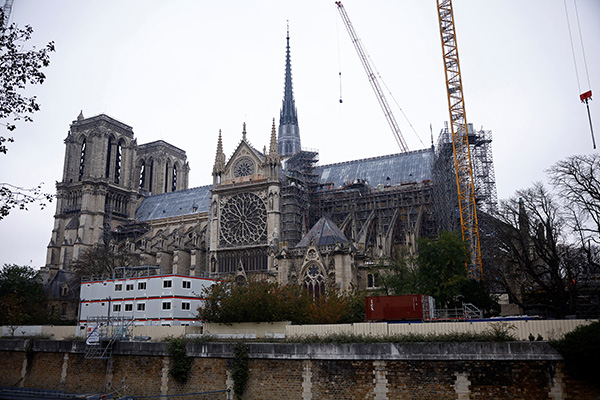
After a fire engulfed Notre Dame Cathedral in 2019, horrified onlookers around the world donated nearly $1 billion to restore the cathedral. While the roof and interior were badly damaged, most of the cathedral's priceless treasures were saved from the flames.
For centuries, the cathedral has witnessed Paris' joys and tragedies, from the golden century of its construction -- which started in 1163 and lasted more than 180 years -- through the terror of the French Revolution and the following reign of Napoleon Bonaparte, who was crowned Emperor of France at its altar.
In 1909, the cathedral saw Pope St. Pius X's beatification of St. Joan of Arc, France's heroine who led battles against the English and was later burned at the stake.
The cathedral witnessed the drama of both World Wars and the liberation of Paris from German Nazi hands, with General Charles de Gaulle participating in a Mass of thanksgiving, following the triumphant march from the Arc de Triomphe down the Champs Elysees and to the cathedral in August 1944.
The cathedral will witness triumph once more when its priceless treasures return to home Dec. 8, the day it reopens after the devastating fire of April 15, 2019.
The first to return will be the Virgin Mary.
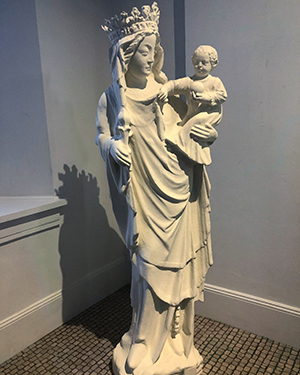 On Nov. 15, an iconic statue that was spared by the fire will be returned to the cathedral: the statue of the Virgin and Child, also referred to as the Virgin of Paris or the Virgin of the Pillar. It has since been housed in the church of Saint-Germain l'Auxerrois, near the Louvre.
On Nov. 15, an iconic statue that was spared by the fire will be returned to the cathedral: the statue of the Virgin and Child, also referred to as the Virgin of Paris or the Virgin of the Pillar. It has since been housed in the church of Saint-Germain l'Auxerrois, near the Louvre.
Dating to the 14th century, the statue was first housed at the Chapel of Saint-Aignan on Paris' Île de la Cité near Notre Dame. In 1818, it was transferred to Notre Dame's exterior as part of the Virgin's portal, replacing the 13th-century Virgin destroyed during the French Revolution. Then, in 1855, Eugène Viollet-le-Duc, the architect charged with restoring the cathedral, moved it to the cathedral transept's southeast pillar near an altar dedicated to Mary.
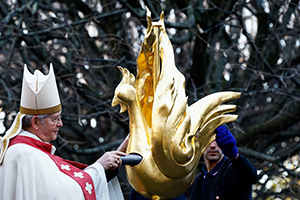 Meanwhile, a new version of an iconic cockerel, or rooster, is once again watching over Paris, symbolizing resilience amid destruction. It was installed Dec. 16, 2023, atop Notre Dame spire's cross.
Meanwhile, a new version of an iconic cockerel, or rooster, is once again watching over Paris, symbolizing resilience amid destruction. It was installed Dec. 16, 2023, atop Notre Dame spire's cross.
Archbishop Laurent Ulrich of Paris blessed the figure, which is a heraldic animal of the French Republic. In a moving moment, he inserted the relics of St. Denis and St. Genevieve, the city's patron saints, inside.
Notre Dame's restoration has included work on other precious sculptures and paintings, but the most anticipated relic is the one that Jesus himself wore on the day of his passion.
The crown of thorns is believed to contain actual pieces of the crown worn by Jesus during his crucifixion, and it is the most precious of the relics in Notre Dame's treasury. It takes the form of a circle, more than 8 inches in diameter. It was saved from the flames on the evening of the cathedral fire by the Parisian fire brigade's chaplain, Father Jean-Marc Fournier.
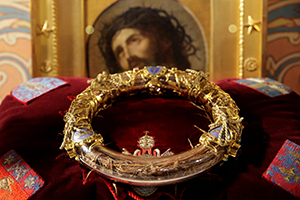 Since the inferno, the crown has been housed at the famous Louvre museum. The relic arrived along with other objects from Notre Dame's treasury: monstrances, chalices, reliquaries, crosses and sacred vessels. The Louvre's teams of experts took charge of cleaning and restoring them. From October 2023 to January 2024, they organized a special exhibition to showcase them.
Since the inferno, the crown has been housed at the famous Louvre museum. The relic arrived along with other objects from Notre Dame's treasury: monstrances, chalices, reliquaries, crosses and sacred vessels. The Louvre's teams of experts took charge of cleaning and restoring them. From October 2023 to January 2024, they organized a special exhibition to showcase them.
But the crown of thorns was not part of the exhibition. "It is not a work of art, but an object of veneration," said Christophe Grunenwald, a knight of the Equestrian Order of the Holy Sepulchre of Jerusalem. "All these objects are prestigious, but none is as valuable as the crown of thorns."
Throughout Lent 2024, the faithful had the opportunity to venerate the crown in the Church of Saint-Germain l'Auxerrois, not far from the Louvre. This is where the daily liturgical services, usually celebrated by the canons of Notre Dame, took place as the cathedral prepared to reopen.
The crown of thorns was venerated in its crystal case adorned with gold foliage, resting on a velvet cushion. But in newly restored Notre Dame, it will have a new, modern case.
In addition, the construction of a new, contemporary-style reliquary shrine is now completed. It consists of a very large openwork wooden panel, surrounded by illuminated glass blocks. The crown will be placed at eye level. It also will house a fragment of the wood of the cross and a crucifixion nail.
In the 13th century, the emperor of Constantinople Baldwin II pawned the crown of thorns to bankers in Venice, Italy, because he needed money. After learning this, French King Louis IX, now St. Louis, collected a considerable sum of money, which enabled him to purchase it from the Venetian bankers. In 1239, the king entered Paris carrying the crown himself, barefoot and dressed in a simple tunic.
"By acquiring this crown, the king of France acquired a special status in the eyes of the Christian West," Grunenwald said. "It placed him in a tradition of Christian ancestry that gave him a privileged place within Christianity in Europe."
To house the crown, Louis IX ordered the building of Sainte-Chapelle within a few years. The architectural gem can still be visited on the Ile de la Cité, not far from Notre Dame.
During the French Revolution, "clever people placed it in the Museum of Natural History with a 'curiosity object' label, so that it would go unnoticed," Grunenwald recounted to OSV News.
At the beginning of the 19th century, once civil and religious peace had been restored in France, Emperor Napoleon handed it over to the archbishop of Paris, who had it placed in the Notre Dame Cathedral. Since then, it has been part of its treasury.
On Dec. 13, a large number of knights and dames of the Equestrian Order of the Holy Sepulchre will take part in a grand ceremony for the crown's transfer to the cathedral. From December until June 2025, the crown will be presented to the faithful every first Friday of the month, as part of Notre Dame's six-month reopening festivities.
— OSV News
Notre Dame is the soul of Paris: Here is what the Gothic cathedral has witnessed in its history
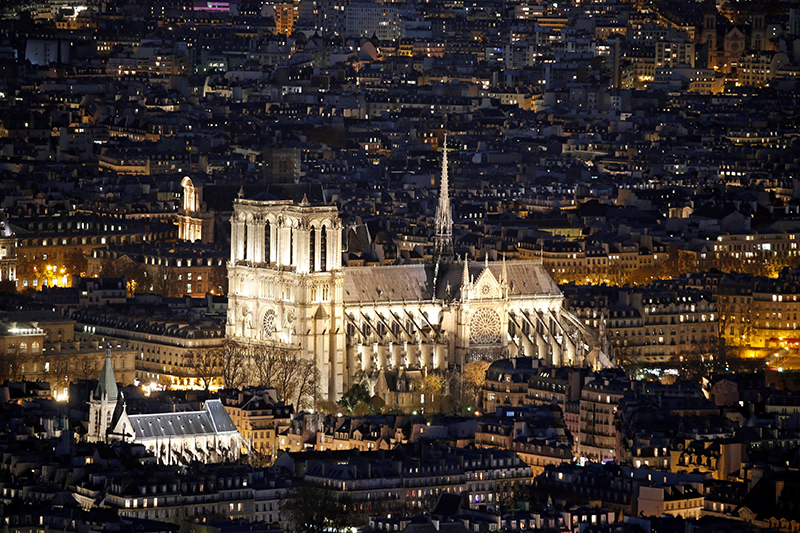
PARIS — On April 15, 2019, when the images of the Cathedral of Notre Dame of Paris on fire reached the screens of millions of people, the shock reverberated throughout the world.
The Gothic cathedral in peril profoundly moved Catholics and nonbelievers. A prowess of architecture, a Gothic masterpiece, Notre Dame has stood firmly through the turmoils of history for more than 850 years.
1163 — The Construction
"If this monument is one day finished, no other will ever compare," declared monk, diplomat and 12th-century chronicler Abbot Robert de Thorigny of Mont Saint-Michel while visiting the building site of Notre Dame around 1177, 14 years after the start of the construction in 1163.
Paris, the most populated city in the Western world with 270,000 inhabitants at the end of the 12th century, was about to enter 150 years of continuous economic growth and development, a feat never repeated since. And it is during this most auspicious period that Notre Dame came to be built. Unlike other Gothic cathedrals in northern France, Notre Dame was uniquely financed, mostly by Maurice de Sully, a son of farmers who had become bishop of Paris, and by Parisians, all kinds of Parisians: prostitutes, peasants and bourgeois.
In fact, little money came from the king and his entourage, thus making Notre Dame the "People's Palace" and the first covered public space accessible to all.
We will indeed never know the name of the architect who, under the direction of Bishop Sully, drew up the plans for Notre Dame. What we know though is that he didn't lack "ambition, technical sophistication, clarity and serenity," according to historian Alain Erlande-Brandenburg.
His designs must have commanded both admiration and immense respect as the three consecutive architects who oversaw the 182 years of construction did not interfere with the original conception. The highest building ever erected in a city, Notre Dame stood at 157 feet wide, 420 feet long and 115 feet high, with two towers reaching 226 feet and, today, a spire at 315 feet high. Rejecting the opulence of the cathedral of Saint-Denis, restored some decades before the start of Notre Dame's construction, Paris' cathedral was unique in her austere beauty, a triumph of both architects' logic and mysticism.
1594 — The Epic Moment
During the French Wars of Religion, Paris quickly became a symbol. Whoever conquered it would become France's only legitimate ruler and the man who would be able to end decades of civil war.
Two sides were fighting each other to death: the Catholic league made of both moderates and extremists who controlled Paris, and Henry of Navarre, in theory king of France but a Protestant backed by royal Catholics, who owned the rich agricultural regions of France.
Of equal force, the outcome of their fratricide war could not be decided on the battlefield. There could only be a political and religious solution to the civil war. Henry of Navarre knew this. He abjured Protestantism in July 1593 and reached out to the moderates holding Paris.
And then, he needed to convince Paris and Parisians. At dawn, on March 22, 1594, riding his white horse, unarmed, he entered Paris with a few thousand of his men. He let Parisians get close to him, and calmly rode towards Notre Dame.
Shouts of "Vive le Roi!" -- "Long live the King!" -- became louder as he approached the steps of the cathedral. Henri IV walked to the choir and knelt in front of the altar to pray for national reconciliation. The hymns and music of the "Te Deum" began filling the nave.
Alerted by the bells, thousands of Parisians joined him in prayer. History remembers him as Henry the Great, the king who had won over the minds and hearts of a divided country.
1789 — The Revolution
Never more than during the French Revolution, did Notre Dame deserve the title of "People's Palace." Chosen by the revolutionaries of all political hues as a place where they would celebrate their success, from the storming of the Bastille -- a medieval armory, fortress and political prison -- to the abolition of all privileges and the Declaration of the Rights of Man and of the Citizen, Notre Dame became for the Revolution a laboratory of ideas in which Providence and the God of reason could only be at their side.
When King Louis XVI was forced to go back to Paris from Versailles, the National Assembly held its first session in Notre Dame. In a historical paradox, it is there that the revolutionaries decided to nationalize all church properties. When the Revolution chose to nationalize the cathedral itself, Notre Dame turned into a huge polling station where citizens could elect their priests, at least those who agreed to swear to the constitutional oath.
The revolutionaries were slowly transforming the cathedral in their own image. Alas, on Oct. 23, 1793, during Maximilien de Robespierre's Reign of Terror, the beheading of the 28 kings of Judah on the cathedral's facade, wrongly thought to be the kings of France, was ordered by decree. However, discreetly, some priests started putting away the treasures in Notre Dame to safety, while the organist kept playing revolutionary songs to appease the sans-culottes ("without-breeches" -- the common people of lower classes that joined the revolution against the Old Regime, or Ancien Régime). Its reconsecration to the "Supreme Being" did not disturb the cathedral, which seemed to patiently wait for Robespierre's fall. It came soon enough in July 1794.
1802-1865 — The Restoration
After national reconciliation and an agreement between the pope and Napoleon Bonaparte in 1802, Notre Dame's bells could resume their daily melody, and Napoleon was crowned emperor in 1804 in a lavish ceremony attended by 12,000 guests.
However, behind the apparent munificence of the event, Notre Dame was dying of old age and neglect. One young man who, in the 1820s, felt it keenly was literary giant Victor Hugo. He tirelessly campaigned for all historical monuments to be safeguarded by law.
"There are two things in a building: its use and its beauty. Its use belongs to the owner, its beauty to everyone, to you, to me, to all of us. Therefore, to destroy it is to exceed one's rights," Hugo famously advocated.
The success of his 1831 novel "Notre Dame de Paris 1482" -- restyled as "The Hunchback of Notre Dame," proved a turning point: A ministry was created to look after France's architectural heritage and a budget was voted on by Parliament.
In 1840, the 30-year-old self-taught architect and Middle-Ages-erudite Eugène Viollet-le-Duc was chosen to restore Notre Dame. It would take almost 25 years to complete. Viollet-le-Duc succeeded in blending his work with the original medieval architecture.
For Philippe Villeneuve, his successor today restoring Notre Dame after the April 15, 2019, fire, "Viollet-Le-Duc's great talent lies in the fact that his work was almost indiscernible from that of the medieval builders. His spire was not identifiable; it could well have dated back to the 13th century."
On Dec. 8, when Notre Dame's gates will open again to the public and to worshippers, Parisians and the world will be able to admire another rebirth of the cathedral, restored after the 2019 fire that collapsed Viollet-le-Duc's and large parts of the roof.
Villeneuve doesn't treat the cathedral's reconstruction merely as a work project. In a conversation with OSV News, he described the cathedral as if it were a human being. "We are giving the cathedral all the elements that will bring it to life," he said. "I would like to give people something that will touch them. I would like to help Notre Dame Cathedral speak to people, as best as it can."
"Life is about transmission. … We are passersby."
— Agnès Poirier writes for OSV News from Paris. She is an author of "Notre Dame: The Soul of France."
Why Notre Dame Cathedral captures hearts and minds worldwide
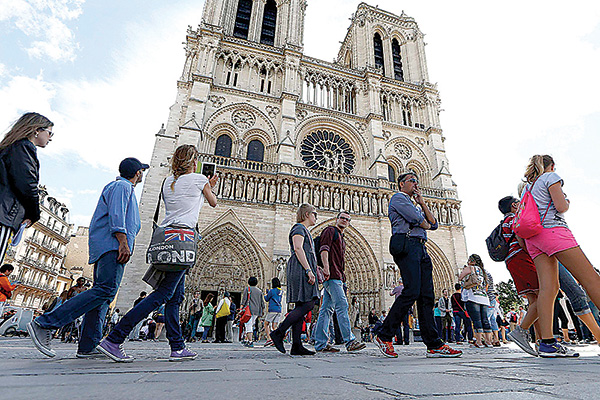
PARIS — In a side chapel not far from the relics of Paris' patroness St. Genevieve in the Church of Saint-Étienne-du-Mont, an easel holds a simple poster requesting prayers under the title "Notre Dame de Paris."
"Let us pray for the people of Paris," it reads. "Let us pray for the Paris archbishop, left without a cathedral."
The exhortation signals the local impact of the 2019 fire that devastated the Cathedral of Notre Dame -- Our Lady -- of Paris and its spiritual significance in the life of that local church. The fire, however, elicited a global outpouring of horror and grief -- and then restoration donations exceeding $920 million from 150 countries -- that highlights the role the cathedral itself occupies in the public imagination, including among the nonreligious, experts and historians said.
Standing on an island in the oldest part of one of Europe's most visited cities, Notre Dame Cathedral sits prominently on Paris' skyline. Since the completion of its famous western facade in 1250 -- more than 600 years before Paris' other prominent landmark, the Eiffel Tower -- the church is seen by many as an icon for the city itself.
"It's Paris that makes Notre Dame so special," said Meredith Cohen, a professor of medieval art and architecture at the University of California, Los Angeles. But, she explained, it's not quite as simple as that.
The Middle Ages -- the period between the collapse of Rome and the Renaissance -- had long been painted as the "dark ages," but that thinking pivoted in the 19th century, said Thomas Burman, the director of the Medieval Institute at the University of Notre Dame in Indiana. The period after 1200 especially became viewed as a time of impressive "artistic flowering," he said.
A common way to illustrate this era is through its great Gothic cathedrals, including Notre Dame, which are among the "great monuments of human civilization," he said.
Located about six miles north of Notre Dame, the Basilica of Saint-Denis, restored to its current design between 1137-1148, is considered the birthplace of Gothic architecture. Construction for Notre Dame began in 1163, placing it among the earliest Gothic cathedrals.
"Cathedrals are always used to depict the grandeur of the high Middle Ages," he said. "These are all held up as signs of this very wealthy, very sophisticated, very artistic period in the history of Europe, and so there have been generations of students educated in this way. So nobody teaches the Middle Ages without showing lots of images of stained-glass windows, without talking about the basic features of Gothic architecture. Notre Dame is a classic instance of Gothic architecture."
What sets Notre Dame apart, he said, is that other -- and even better -- examples of Gothic cathedrals, such as those in Amiens and Chartres, France, and Cologne, Germany, aren't in a tourist mecca like Paris. Add to that Paris' building codes, which mean there are few tall buildings in its city center.
"Thus the Eiffel Tower and Notre Dame really show up," Burman said.
For Burman, the global interest in Notre Dame's recent rebuilding also reflects "enduring fascination with the Middle Ages," indicated by the "medieval-esque" popular culture of books, movies, TV series and video games such as "The Lord of the Rings" and the "Game of Thrones."
After extensive restoration, the cathedral is set to reopen to the public Dec. 8.
On the evening of April 15, 2019, the fire engulfed the cathedral's spire -- a 19th-century addition -- and most of its timber-framed roof. Falling embers, debris and smoke damaged the interior as heroic efforts were made to save important artworks and artifacts, including the relic of Christ's crown of thorns.
To have completely lost Notre Dame would have been like "ripping out the heart of Paris," said Michael Davis, professor emeritus at Mount Holyoke College in South Hadley, Massachusetts.
On that Holy Monday in 2019, thousands of people lined up the streets of Paris to pray that their beloved cathedral would be saved amid a horrific view of flames and smoke rising around its spire.
"At Notre Dame, crowds of pilgrims and visitors will be able to experience his presence and unconditional welcome, in the beauty of a work of art, a celebration, a church song. ... This is what we are working on with great zeal," Archbishop Laurent Ulrich of Paris told OSV News in April.
"Today, Western society is distraught, often desperate. In this context, the restoration of Notre Dame is a tremendous sign of hope. Paris is going to get its cathedral back, and that does not just concern Catholics. The hope it represents must inspire all those who will be thrilled by the reopening," the cathedral's rector-archpriest, Father Olivier Ribadeau Dumas, told OSV News April 10.
Notre Dame has been saved before -- not by firefighters but by literature. The international success of Victor Hugo's 1831 novel "Notre Dame de Paris 1482" -- restyled as "The Hunchback of Notre Dame" -- was key for inspiring efforts to restore the dilapidated cathedral after -- and in spite of -- the French Revolution, several experts said.
The book "enshrined the cathedral as almost a kind of document or chronicle of the history of France, of science and the arts, and that history is really kind of inscribed on its stones in every way, and that its this real emblem of France," said Davis, who sits on the board of directors of Friends of Notre-Dame de Paris, a nonprofit organization raising funds to restore the cathedral.
At the time Hugo wrote "The Hunchback of Notre Dame," Gothic architecture had lost its cache and was being demolished to make way for newer styles, said Thibault Schilt, a professor and program coordinator of French and Francophone Studies at the College of the Holy Cross in Worcester, Massachusetts.
Meanwhile, the anti-Catholic fervor of the French Revolution persisted. With the book, Hugo (who, decades later, would also write "Les Misérables") wanted to remind the French that Notre Dame "was a jewel, and that it needed to be protected and revered, and that it needed to be respected," said Schilt, who grew up in France.
The book was published in English in 1833. "Both in France and abroad, it contributed to its renaissance in the minds of the people," Schilt said. "It made them realize that it was a very special cathedral. And it is so easy to fall in love with it, because it has all of these gargoyles. It's so quirky."
More important than the ballets, plays and films the book would inspire, it prompted the architect Eugène Viollet-le-Duc to undertake the restoration of Notre Dame itself. That coincided with the heyday of the "grand tour," another key factor in enduring affection for Paris and its cathedral, Schilt said. By the mid-1800s, the long-standing standard European tour for primarily English aristocrats had begun attracting Americans. Paris was a main attraction.
Cohen agrees on the importance of the 19th century to public fascination with Notre Dame.
"Notre Dame and its fame really comes from the 19th century, after the French Revolution and a lot of the destruction of the city," said Cohen, who specializes in the history of medieval Parisian architecture. "Post-revolution, transformations, urbanization happened to open up the cities. And that's when the modern city was born, with the big avenues and Impressionism and all that -- modernity -- and it coincided with the Industrial Revolution, too."
That progressive movement stirred in France "a collective kind of nostalgia for the Middle Ages, for the past -- the past that's quickly slipping away because of those major transformations," she said.
While the post-Revolution destruction of Gothic architecture, especially churches, was a way for revolutionaries to demonstrate a break with the Catholic Church, the country's Gothic cathedrals have come to be treasured because they represent "a particularly French history," Cohen said.
Beyond France, "Notre Dame has become a kind of symbol that just transcends some of its historical importance," she said. "People love Paris. They love it because it's Paris -- food, art, culture." So, she said, when Notre Dame was burning, it was, for many, as if Paris itself was burning.
Cohen sees a silver lining in the fire, in that the restoration could draw people's attention to the significance of historic architecture.
"I hope it inspires them not just to go to Paris," she said, "but maybe to study the history of these 1,000-year-old buildings."
— Maria Wiering, OSV News
Notre Dame's choir is ready to sing again at home as cathedral's bells ring anew
PARIS — In a much anticipated moment, for the first time in more than five years, the eight bells of the north tower of Notre Dame Cathedral in Paris rang out again on Nov. 8. "It is a beautiful, important and symbolic step," said Philippe Jost, head of the team overviewing the cathedral's restoration, cited in French Catholic newspaper "La Croix."
In fact, sounds are an inseparable part of Notre Dame's beauty. Victor Hugo, a French literary giant who helped bring attention to a crumbling Notre Dame Cathedral in 19th century with "Notre Dame de Paris 1482" -- restyled as "The Hunchback of Notre Dame," wrote that the cathedral acoustics and sound were "fraught with such benediction and such majesty, that they soothed this ailing soul."
This is precisely what Henri Chalet, a qualified organist, director of the prestigious La Maîtrise Notre Dame de Paris choir since 2014, was longing to see, or rather hear, again.
The Maîtrise choir that "found itself orphaned" after the devastating April 15, 2019, fire that collapsed the spire and part of Notre Dame's roof, causing extensive damage inside, will be back in Paris' cathedral from Dec. 7, after five years of work on the cathedral's restoration.
For eight days, Paris' famous musicians will be mobilized for a packed schedule of ceremonies, including a special concert on Dec. 17 and 18, featuring Johann Sebastian Bach's "Magnificat."
Chalet is putting the finishing touches to an exceptionally rich program for the year 2025, which he describes as "historic," featuring internationally renowned musicians and soloists.
Guest musicians will include American cellist Yo-Yo Ma, born to Chinese parents in Paris, raised and educated in New York City, who will play on the evening of March 25. He will perform Bach's six cello suites, and three motets specially composed for Notre Dame's reopening by the young French composer Lise Borel, and based on prayers by St. Francis of Assisi."
The concert program will cover 1,000 years of repertoire, from medieval Gregorian to contemporary creations," Chalet explained to OSV News.
Traditional iconic works will also be presented, such as Wolfgang Amadeus Mozart's "Requiem," Bach's "St. John Passion" and another "Requiem" by Gabriel Fauré.
"We are all looking forward to this particular period with great emotion," Chalet said. "The Maîtrise is 850 years old, just like the cathedral itself. Notre Dame was the birthplace of polyphonic singing and rhythmic writing. We are bound to its history."
Thirty years ago, the Maîtrise Notre Dame received a new impetus, thanks to the collaboration of the state, the church and the city of Paris.
The choir "had partly lost its influence since the French Revolution, unlike English and German church choirs," Chalet explained. "But in 1991, three strong personalities, Cardinal Jean-Marie Lustiger, archbishop of Paris, Mayor of Paris Jacques Chirac, future French president, and Jack Lang, minister of culture, decided to combine their efforts to enable it to regain its excellence and prestige," Chalet emphasized.
The blue alb worn today by Notre Dame choristers, in reference to the Virgin Mary, dates from this period.
Today, the Maîtrise has returned to a level of excellence, and is one of France's leading vocal and choral training centers. It brings together 150 student choristers -- the youngest being merely 5 years old -- divided into four choirs.
Before the fire, it provided music for some 1,200 liturgical services a year in the cathedral, and a concert every Tuesday evening. "We were at Notre Dame almost every day," Chalet recounted. "With the fire, from one day to the next, we found ourselves without a 'home.' We had to figure out how to survive, and invent a new rhythm to keep moving forward, passing on this ages-old know-how to young people."
During the restoration works, the Maîtrise performed daily services in the church of Saint-Germain l'Auxerrois, and gave concerts in other churches, abbeys and cathedrals in France.
Saint-Germain l'Auxerrois is located directly across the street from the Louvre Palace and the iconic Notre Dame sculpture called the Virgin of the Pillar, or the Virgin of Paris, also found a new temporary home there, until it is returned to the restored cathedral at the end of November.
"We tried to take advantage of these opportunities to make the cathedral and its choir better known to the outside world," Chalet explained. "We were invited to prestigious venues in Paris, such as the Opéra Garnier, or the Théâtre des Champs Elysées, where we had never sung before."
Chalet recalled that what was truly exceptional was the tour of the United States in October 2023.
"This was a first," he said. "Previously, we never went abroad, with a few exceptions in Europe." The Maîtrise adult choir visited New York, Cleveland, Atlanta, Huntsville (Alabama), Dallas and Chicago for sold-out concerts.
"It was a great success," Chalet said. "We were happy to sing for an audience that we felt was passionate about Notre Dame. It was a way of thanking the Americans for their great interest and generosity in its restoration."
Today, Chalet hopes to be able to at least once rehearse in the cathedral with the entire Maîtrise before the Dec. 7 start of reopening ceremonies, but nothing is certain yet.
"The work is still underway and the schedule is tight," he said. "At this very moment, specialists are working through the night, when the noise of the construction work is gone, to tune the great organ. There is a lot of work to be done, with its 8,000 pipes having been cleaned of the lead dust that covered them during the night of the fire," he said.
For his part, Chalet has been able to enter Notre Dame twice since the fire. "I sang there in December 2020 with a few choristers," he said. "Restoration work had just begun. There were still holes in the vault, and it was extremely cold. But the emotion was enormous to see that, despite everything, the cathedral was standing."
In December 2023, he reentered the cathedral to record Christmas carols. "There were 16 of us this time," he recounted. "The work had progressed well, but the scaffolding was still there, and the protocol remained very strict. We were wearing helmets and boots, and protective suits under our blue albs, because of the risk of lead pollution."
"It was a real joy to see this white stone of the cathedral, cleaned," he said. "We discovered the cathedral all lit up!"
Emotions are extremely high as the reopening approaches, he said. "Some of the children, who were very young at the time of the fire, remember singing in the cathedral. They are about 15 now, and cannot wait to get inside again," he recounted. "They will discover a different cathedral, bright and beautifully enhanced," Chalet said.
"We have sung in a lot of beautiful places in recent years," he concluded. "But at Notre Dame, there is 'something extra.' It is a place that speaks to everyone, and to the whole world. It is going to be a great thrill to be able to return there."
— Caroline de Sury, OSV News


